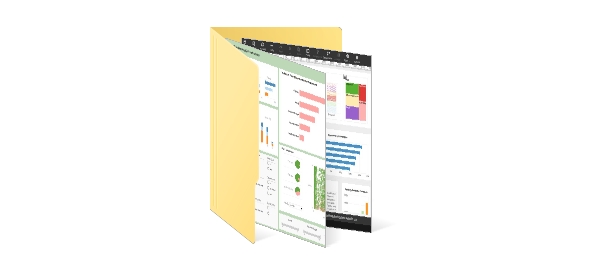Contrast with the Traditional ETL and Data Warehousing Only Model
This is the continuation of the transcript of a Webinar hosted by InetSoft in on the topic of "Agile BI Best Practices" The speaker is Mark Flaherty, CMO at InetSoft.
There is a ton of useful information stored in enterprise databases and employees spreadsheets that's really important. And speed of making that data available is key. I mean in hours, not months. This is key to agile BI. This is in contrast with the traditional ETL and data warehouse only model. We are responding to data requirements. This old model takes months to put in place. This is sort of the technical side. In the next few minutes we will build on this.
From the survey results. it looks like the majority of people are not currently implementing an agile BI program in their organizations, and I found that quite interesting. So this webinar should be really helpful to them, and now we are going to move forward and talk about what agile BI means.
For a comprehensive definition, I would say agile business intelligence addresses the broad need to enable flexibility by accelerating the time it takes to deliver value. A key theme is, be flexible and fast, and again, using some of these scrum and extreme programming techniques can get you there.
It can include technology deployment options such as self-service BI, access to cloud-based data, and data discovery dashboards that allow users to begin working with data more rapidly and adjusting to changing needs. There are varied end-user options and there are new technologies that have come in the last few years such as interactive visualizations.
Transforming BI Projects
Then I talk about transforming BI projects to fit the dynamic user requirements, implementing a formal methodology, utilizing agile software development techniques and tools to accelerate development, testing, deployment; ongoing scoping, rapid iterations, working components, evolving requirements, scrum sessions, frequent thorough testing, business development, and communication.
This agile BI development is an IT managed process that uses a bunch of some of the new development techniques and tools that are proving to be really effective at the most successful software companies and IT shops. And then the other aspect that keeps coming up is business intelligence on mobile devices. As we read through the blogs, the conferences, they are coming up a lot.
There is addition to this, there is now hardware platforms that users are getting that allow them to be far more mobile and able to access information basically anywhere, any time, any place. So as we look at the technical side of the discussion, these are the things that seem to come up: flexible, fast, varied access options, an IT centrally managed process, and mobility.
The other side of that is the end-user side, and a lot of the writing has been about the technical side. The end-user side seems to have had less coverage in at least what we surveyed, which is pretty broad. What we see end users wanting is quick and flexible access to data, and there are more and more sources of data, intuitive display and easy interaction.End-User Expectations
They want to be able to consume BI on their own without having to go back to experts for help. They want access from anywhere anytime, which has this whole mobile device trend so hot. What is helping to enable it are web-based BI systems and data mashups. End-users have found legacy BI systems too difficult to understand and interact with.
It's not that they want the same thing developed and deployed faster, which is a key point. It's something different. Rather they are looking for new paradigms with which to understand their information and easily interact with it. So the counterpoint is, yes we want to implement BI faster, more flexibly, but we also want to implement something new and different, something that’s more enabling. So that actually gets into the next section.
We are going to launch another survey here The question is, what is the goal of BI in your company? And if you are indeed using an agile BI strategy right now, we are interested in finding out what is your role in that, so that the survey is up, we are going to wait about 20 seconds for people to answer.
What Are the Features of StyleBI That Differentiate It from Traditional BI Solutions?
- Serverless Architecture: StyleBI is a lightweight, cloud-native analytics microservice that eliminates the need for traditional BI infrastructure, making it easier to deploy and scale without IT overhead.
- Real-Time Data Mashups: Unlike traditional BI tools that rely heavily on pre-processed data warehouses, StyleBI enables live, on-demand data blending from multiple sources, including APIs, databases, and flat files.
- No-Code/Low-Code Interface: Business users can create dashboards, perform data transformations, and explore insights visually without relying on technical teams or writing complex scripts.
- Embedded and Headless BI Capabilities: StyleBI supports embedding analytics directly into SaaS platforms or applications, and can function as a headless BI service to deliver data visualizations programmatically.
- Self-Service Data Exploration: Users are empowered to build their own reports, customize dashboards, and drill into data with drag-and-drop tools, reducing bottlenecks often associated with centralized BI teams.
- Lightweight Footprint: StyleBI is designed for efficiency and agility, consuming minimal resources while delivering enterprise-grade analytics functionality.
- Native Cloud Compatibility: Built with cloud flexibility in mind, StyleBI integrates seamlessly with modern data stacks, including cloud-native data lakes and platforms.
- Rapid Deployment: With its pre-configured modules and intuitive interface, organizations can go from setup to insights in a fraction of the time required by traditional BI systems.
- Interactive Visual Dashboards: StyleBI provides highly interactive, real-time dashboards that support advanced filtering, drill-downs, and responsive design for mobile and web.
- Flexible Data Governance: Fine-grained control over user access, data visibility, and security ensures compliance with organizational and regulatory requirements.



